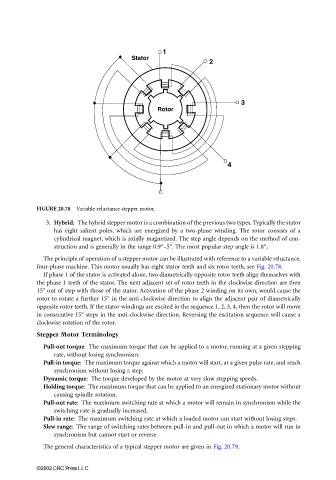Page 578 - The Mechatronics Handbook
P. 578
0066_Frame_C20 Page 48 Wednesday, January 9, 2002 5:49 PM
1
Stator
2
3
Rotor
4
FIGURE 20.78 Variable reluctance stepper motor.
3. Hybrid: The hybrid stepper motor is a combination of the previous two types. Typically the stator
has eight salient poles, which are energized by a two-phase winding. The rotor consists of a
cylindrical magnet, which is axially magnetized. The step angle depends on the method of con-
struction and is generally in the range 0.9°–5°. The most popular step angle is 1.8°.
The principle of operation of a stepper motor can be illustrated with reference to a variable reluctance,
four-phase machine. This motor usually has eight stator teeth and six rotor teeth, see Fig. 20.78.
If phase 1 of the stator is activated alone, two diametrically opposite rotor teeth align themselves with
the phase 1 teeth of the stator. The next adjacent set of rotor teeth in the clockwise direction are then
15° out of step with those of the stator. Activation of the phase 2 winding on its own, would cause the
rotor to rotate a further 15° in the anti-clockwise direction to align the adjacent pair of diametrically
opposite rotor teeth. If the stator windings are excited in the sequence 1, 2, 3, 4, then the rotor will move
in consecutive 15° steps in the anti-clockwise direction. Reversing the excitation sequence will cause a
clockwise rotation of the rotor.
Stepper Motor Terminology
Pull-out torque: The maximum torque that can be applied to a motor, running at a given stepping
rate, without losing synchronism.
Pull-in torque: The maximum torque against which a motor will start, at a given pulse rate, and reach
synchronism without losing a step.
Dynamic torque: The torque developed by the motor at very slow stepping speeds.
Holding torque: The maximum torque that can be applied to an energized stationary motor without
causing spindle rotation.
Pull-out rate: The maximum switching rate at which a motor will remain in synchronism while the
switching rate is gradually increased.
Pull-in rate: The maximum switching rate at which a loaded motor can start without losing steps.
Slew range: The range of switching rates between pull-in and pull-out in which a motor will run in
synchronism but cannot start or reverse.
The general characteristics of a typical stepper motor are given in Fig. 20.79.
©2002 CRC Press LLC

